Non-Destructive Evaluation of Damage and Electricity Characteristics in 4H-SiC Induced by Ion Irradiation via Raman Spectroscopy
Abstract
1. Introduction
2. Materials and Methods
3. Results and Discussion
3.1. Raman Spectra of 4H-SiC Irradiated with O and Au Ions
3.2. Relative Disorder of 4H-SiC Irradiated with O and Au Ions
3.3. Carrier Concentration and Mobility of 4H-SiC Irradiated with O and Au Ions
3.4. The Evolution of Electrical Performance in Irradiated 4H-SiC
4. Conclusions
Author Contributions
Funding
Institutional Review Board Statement
Informed Consent Statement
Data Availability Statement
Acknowledgments
Conflicts of Interest
Abbreviations
| SiC | silicon carbide |
| LOPC | longitudinal optical phonon–plasmon coupling |
| LO | longitudinal optical |
| TO | transverse optical |
| MCM | metal–semiconductor–metal |
| SRIM | Stopping and Range of Ions in Matter |
| I–V | current–voltage |
| RBS/C | Rutherford backscattering spectroscopy in channeling |
| TEM | transmission electron microscopy |
| MOCVD | metal–organic chemical vapor deposition |
References
- Hu, G.; Zhong, G.; Xiong, X. Improvement of the Resistivity Uniformity of 8-Inch 4H-SiC Wafers by Optimizing the Thermal Field. Vacuum 2024, 222, 112961. [Google Scholar] [CrossRef]
- Zhang, Q.; Liu, Y.; Li, H.; Wang, J.; Wang, Y.; Cheng, F.; Han, H.; Zhang, P. A Review of SiC Sensor Applications in High-Temperature and Radiation Extreme Environments. Sensors 2024, 24, 7731. [Google Scholar] [CrossRef]
- Clark, P.E.; Rilee, M.L. Remote Sensing Tools for Exploration: Observing and Interpreting the Electromagnetic Spectrum; Springer: New York, NY, USA, 2010; pp. 114–177. [Google Scholar] [CrossRef]
- Abd El-Hameed, A.M. Radiation Effects on Composite Materials Used in Space Systems: A Review. NRIAG J. Astron. Geophys. 2022, 11, 313–324. [Google Scholar] [CrossRef]
- Chakravorty, A.; Singh, B.; Jatav, H.; Meena, R.; Kanjilal, D.; Kabiraj, D. Controlled Generation of Photoemissive Defects in 4H-SiC Using Swift Heavy Ion Irradiation. J. Appl. Phys. 2021, 129, 245905. [Google Scholar] [CrossRef]
- Setera, B.; Christou, A. Challenges of Overcoming Defects in Wide Bandgap Semiconductor Power Electronics. Electronics 2021, 11, 10. [Google Scholar] [CrossRef]
- Wang, X.; Wan, W.; Shen, S.; Wu, H.; Zhong, H.; Jiang, C.; Ren, F. Application of Ion Beam Technology in (Photo)electrocatalytic Materials for Renewable Energy. Appl. Phys. Rev. 2020, 7, 041303. [Google Scholar] [CrossRef]
- Ma, H.; Fan, P.; Qian, Q.; Zhang, Q.; Li, K.; Zhu, S.; Yuan, D. Nanoindentation Test of Ion-Irradiated Materials: Issues, Modeling and Challenges. Materials 2024, 17, 3286. [Google Scholar] [CrossRef]
- Jain, I.; Agarwal, G. Ion Beam Induced Surface and Interface Engineering. Surf. Sci. Rep. 2011, 66, 77–172. [Google Scholar] [CrossRef]
- Liu, T.; Liu, P.; Zhang, L.; Zhou, Y.F.; Yu, X.F.; Zhao, J.H.; Wang, X.L. Visible and Near-Infrared Planar Waveguide Structure of Polycrystalline Zinc Sulfide from C Ions Implantation. Opt. Express 2013, 21, 4671–4676. [Google Scholar] [CrossRef]
- Liu, Y.; Crespillo, M.L.; Huang, Q.; Wang, T.J.; Liu, P.; Wang, X.L. Lattice Damage Assessment and Optical Waveguide Properties in LaAlO3 Single Crystal Irradiated with Swift Si Ions. J. Phys. D Appl. Phys. 2017, 50, 055101. [Google Scholar] [CrossRef]
- Liu, Y.; Huang, Q.; Xue, H.Z.; Crespillo, M.L.; Liu, P.; Wang, X.L. Thermal Spike Response and Irradiation-Damage Evolution of a Defective YAlO3 Crystal to Electronic Excitation. J. Nucl. Mater. 2018, 499, 312–316. [Google Scholar] [CrossRef]
- Weber, W.J.; Zarkadoula, E.; Pakarinen, O.H.; Sachan, R.; Chisholm, M.F.; Liu, P.; Xue, H.; Jin, K.; Zhang, Y.W. Synergy of Elastic and Inelastic Energy Loss on Ion Track Formation in SrTiO3. Sci. Rep. 2015, 5, 7726. [Google Scholar] [CrossRef]
- Markelj, S.; Jin, X.; Djurabekova, F.; Zavašnik, J.; Punzón-Quijorna, E.; Schwarz-Selinger, T.; Crespillo, M.; López, G.G.; Granberg, F.; Lu, E. Unveiling the Radiation-Induced Defect Production and Damage Evolution in Tungsten Using Multi-Energy Rutherford Backscattering Spectroscopy in Channeling Configuration. Acta Mater. 2024, 263, 119499. [Google Scholar] [CrossRef]
- Jagielski, J.; Jozwik, P. RBS/C, HRTEM and HRXRD Study of Damage Accumulation in Irradiated SrTiO3. Radiat. Eff. Defects Solids 2013, 168, 442–449. [Google Scholar] [CrossRef]
- Jalluri, T.D.; Rao, B.V.; Rudraswamy, B.; Venkateswaran, R.; Sriram, K. Optical Polishing and Characterization of Chemical Vapour Deposited Silicon Carbide Mirrors for Space Applications. J. Opt. 2023, 52, 969–983. [Google Scholar] [CrossRef]
- Madito, M.; Hlatshwayo, T.; Mtshali, C. Chemical Disorder of a-SiC Layer Induced in 6H-SiC by Cs and I Ions Co-Implantation: Raman Spectroscopy Analysis. Appl. Surf. Sci. 2021, 538, 148099. [Google Scholar] [CrossRef]
- Sreelakshmi, N.; Amirthapandian, S. Raman Scattering Investigations on Disorder and Recovery Induced by Low and High Energy Ion Irradiation on 3C-SiC. Mater. Sci. Eng. B 2021, 273, 115452. [Google Scholar] [CrossRef]
- Jiang, G.; Haiyang, F.; Bo, P.; Renke, K. Recent Progress of Residual Stress Measurement Methods: A Review. Chin. J. Aeronaut. 2021, 34, 54–78. [Google Scholar] [CrossRef]
- Zhang, P.; Fan, J. Insights into the Role of Defects on the Raman Spectroscopy of Carbon Nanotube and Biomass-Derived Carbon. Carbon 2024, 222, 118998. [Google Scholar] [CrossRef]
- Kuball, M.; Hayes, J.M.; Suski, T.; Jun, J.; Leszczynski, M.; Domagala, J.; Tan, H.H.; Williams, J.S.; Jagadish, C. High-Pressure High-Temperature Annealing of Ion-Implanted GaN Films Monitored by Visible and Ultraviolet Micro-Raman Scattering. J. Appl. Phys. 2000, 87, 2736–2741. [Google Scholar] [CrossRef]
- Zhang, L.; Zhang, C.; Xian, Y.; Liu, J.; Ding, Z.; Yan, T.; Chen, Y.; Su, C.; Li, J.; Liu, H. Degradation Mechanisms of Optoelectric Properties of GaN via Highly-Charged 209Bi33+ Ions Irradiation. Appl. Surf. Sci. 2018, 440, 814–820. [Google Scholar] [CrossRef]
- Harima, H.; Nakashima, S.I.; Uemura, T. Raman Scattering from Anisotropic LO-Phonon-Plasmon-Coupled Mode in n-Type 4H- and 6H-SiC. J. Appl. Phys. 1995, 78, 1996–2005. [Google Scholar] [CrossRef]
- Chafai, M.; Jaouhari, A.; Torres, A.; Antón, R.; Martín, E.; Jiménez, J.; Mitchel, W. Raman Scattering from LO Phonon-Plasmon Coupled Modes and Hall-Effect in n-Type Silicon Carbide 4H-SiC. J. Appl. Phys. 2001, 90, 5211–5215. [Google Scholar] [CrossRef]
- Yang, S.; Tokunaga, S.; Kondo, M.; Nakagawa, Y.; Shibayama, T. Non-Destructive Evaluation of the Strain Distribution in Selected-Area He+ Ion Irradiated 4H-SiC. Appl. Surf. Sci. 2020, 500, 144051. [Google Scholar] [CrossRef]
- Zhang, L.Q.; Zhang, C.H.; Li, J.J.; Meng, Y.C.; Yang, Y.T.; Song, Y.; Ding, Z.N.; Yan, T.X. Damage to epitaxial GaN layer on Al2O3 by 290-MeV 238U32+ ions irradiation. Sci. Rep. 2018, 8, 4121. [Google Scholar] [CrossRef] [PubMed]
- Zhu, D.; Luo, W. H+ Implantation Induced Defects Distribution in 4H-SiC Single Crystal Film Fabricated by Crystal-Ion-Slicing and Its Effects on Electrical Behavior: A Multiple Characterization Study. Appl. Surf. Sci. 2024, 670, 160673. [Google Scholar] [CrossRef]
- Sorieul, S.; Costantini, J.; Gosmain, L.; Thomé, L.; Grob, J. Raman Spectroscopy Study of Heavy-Ion-Irradiated α-SiC. Phys. Condens. Matter 2006, 18, 5235. [Google Scholar] [CrossRef]
- Feng, Z.C.; Zhao, D.; Wan, L.; Lu, W.; Yiin, J.; Klein, B.; Ferguson, I.T. Angle-Dependent Raman Scattering Studies on Anisotropic Properties of Crystalline Hexagonal 4H-SiC. Materials 2022, 15, 8751. [Google Scholar] [CrossRef]
- Zhao, J.; Ye, L.; Jiao, X.; Yue, Q.; Liu, Y. The Damage Investigations of 4H–SiC after P-Ion Irradiation. Appl. Phys. A 2020, 126, 531. [Google Scholar] [CrossRef]
- Ehbrecht, M.; Ferkel, H.; Huisken, F.; Holz, L.; Polivanov, Y.N.; Smirnov, V.; Stelmakh, O.; Schmidt, R. Deposition and Analysis of Silicon Clusters Generated by Laser-Induced Gas Phase Reaction. J. Appl. Phys. 1995, 78, 5302–5306. [Google Scholar] [CrossRef]
- Liu, H.; Wu, H.; Zhang, H.; Yuan, M.; Chen, J.; Chen, Z.; Liu, X.; Huang, Z. Preparation, Microstructure and Ion-Irradiation Damage Behavior of Al4SiC4-Added SiC Ceramics. Ceram. Int. 2022, 48, 24592–24598. [Google Scholar] [CrossRef]
- Sorieul, S.; Kerbiriou, X.; Costantini, J.; Gosmain, L.; Calas, G.; Trautmann, C. Optical Spectroscopy Study of Damage Induced in 4H-SiC by Swift Heavy Ion Irradiation. Phys. Condens. Matter 2012, 24, 125801. [Google Scholar] [CrossRef]
- Ishimaru, M.; Zhang, Y.; Weber, W.J. Radiation-Induced Chemical Disorder in Covalent Materials. MRS Online Proc. Libr. 2011, 1298, 117–124. [Google Scholar] [CrossRef]
- Menzel, R.; Gärtner, K.; Wesch, W.; Hobert, H. Damage Production in Semiconductor Materials by a Focused Ga⁺ Ion Beam. J. Appl. Phys. 2000, 88, 5658–5661. [Google Scholar] [CrossRef]
- Zhang, Y.; Weber, W.J.; Jiang, W.; Wang, C.M.; Shutthanandan, V.; Hallen, A. Effects of Implantation Temperature on Damage Accumulation in Al-Implanted 4H-SiC. J. Appl. Phys. 2004, 95, 4012–4018. [Google Scholar] [CrossRef]
- Jiang, W.; Zhang, Y.; Weber, W.J. Temperature Dependence of Disorder Accumulation and Amorphization in Au-Ion-Irradiated 6H-SiC. Phys. Rev. B 2004, 70, 165208. [Google Scholar] [CrossRef]
- Jiang, W.; Weber, W.J.; Zhang, Y.; Thevuthasan, S.; Shutthanandan, V. Ion Beam Analysis of Irradiation Effects in 6H-SiC. Nucl. Instrum. Methods Phys. Res. B 2003, 207, 92–99. [Google Scholar] [CrossRef]
- Zhang, Y.; Weber, W.J.; Jiang, W.; Hallén, A.; Possnert, G. Damage Evolution and Recovery on Both Si and C Sublattices in Al-Implanted 4H-SiC Studied by Rutherford Backscattering Spectroscopy and Nuclear Reaction Analysis. J. Appl. Phys. 2002, 91, 6388–6395. [Google Scholar] [CrossRef]
- Zhang, Y.; Weber, W.J.; Jiang, W.; Shutthanandan, V.; Thevuthasan, S.; Janson, M.; Hallen, A. Annealing Behavior of Al-Implantation-Induced Disorder in 4H-SiC. Nucl. Instrum. Methods Phys. Res. B 2004, 219–220, 647–651. [Google Scholar] [CrossRef]
- Gao, F.; Weber, W.J. Cascade Overlap and Amorphization in 3C-SiC: Defect Accumulation, Topological Features, and Disordering. Phys. Rev. B 2002, 66, 024106. [Google Scholar] [CrossRef]
- Gao, F.; Weber, W. Computer Simulation of Disordering and Amorphization by Si and Au Recoils in 3C-SiC. J. Appl. Phys. 2001, 89, 4275–4281. [Google Scholar] [CrossRef]
- Hon, D.; Faust, W. Dielectric Parameterization of Raman Lineshapes for GaP with a Plasma of Charge Carriers. J. Appl. Phys. 1973, 1, 241–256. [Google Scholar] [CrossRef]
- Irmer, G.; Toporov, V.; Bairamov, B.; Monecke, J. Determination of the Charge Carrier Concentration and Mobility in n-GaP by Raman Spectroscopy. Phys. Status Solidi B 1983, 119, 595–603. [Google Scholar] [CrossRef]
- Li, H.; Liu, C.; Zhang, Y.; Qi, C.; Wei, Y.; Zhou, J.; Wang, T.; Ma, G.; Wang, Z.; Dong, S. Irradiation Effect of Primary Knock-on Atoms on Conductivity Compensation in N-Type 4H-SiC Schottky Diode under Various Irradiations. Semicond. Sci. Technol. 2019, 34, 095010. [Google Scholar] [CrossRef]
- Almaz, E.; Stone, S.; Blue, T.E.; Heremans, J.P. The Effects of Neutron Irradiation and Low Temperature Annealing on the Electrical Properties of Highly Doped 4H Silicon Carbide. Nucl. Instrum. Methods Phys. Res. A 2010, 622, 200–206. [Google Scholar] [CrossRef]
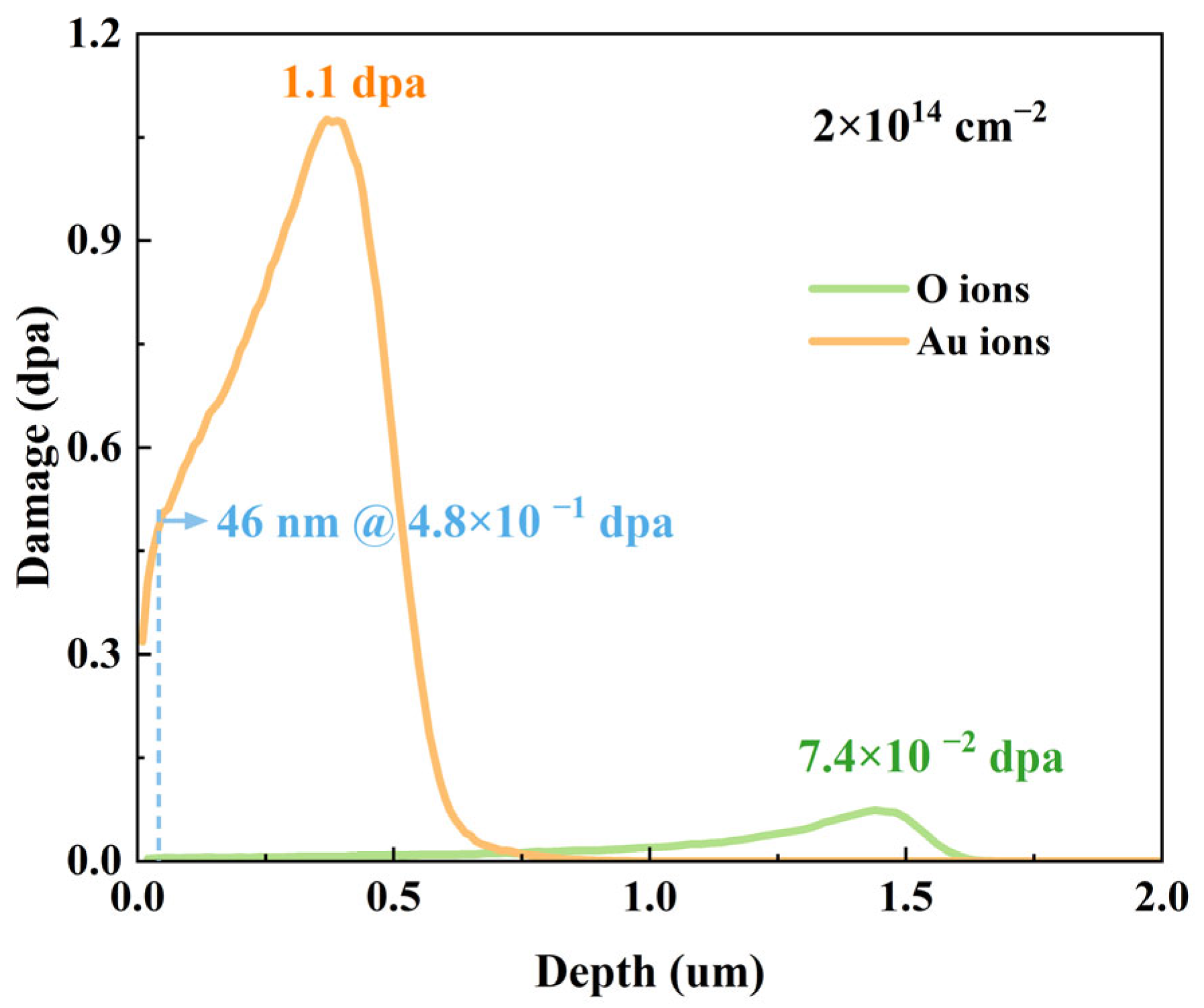
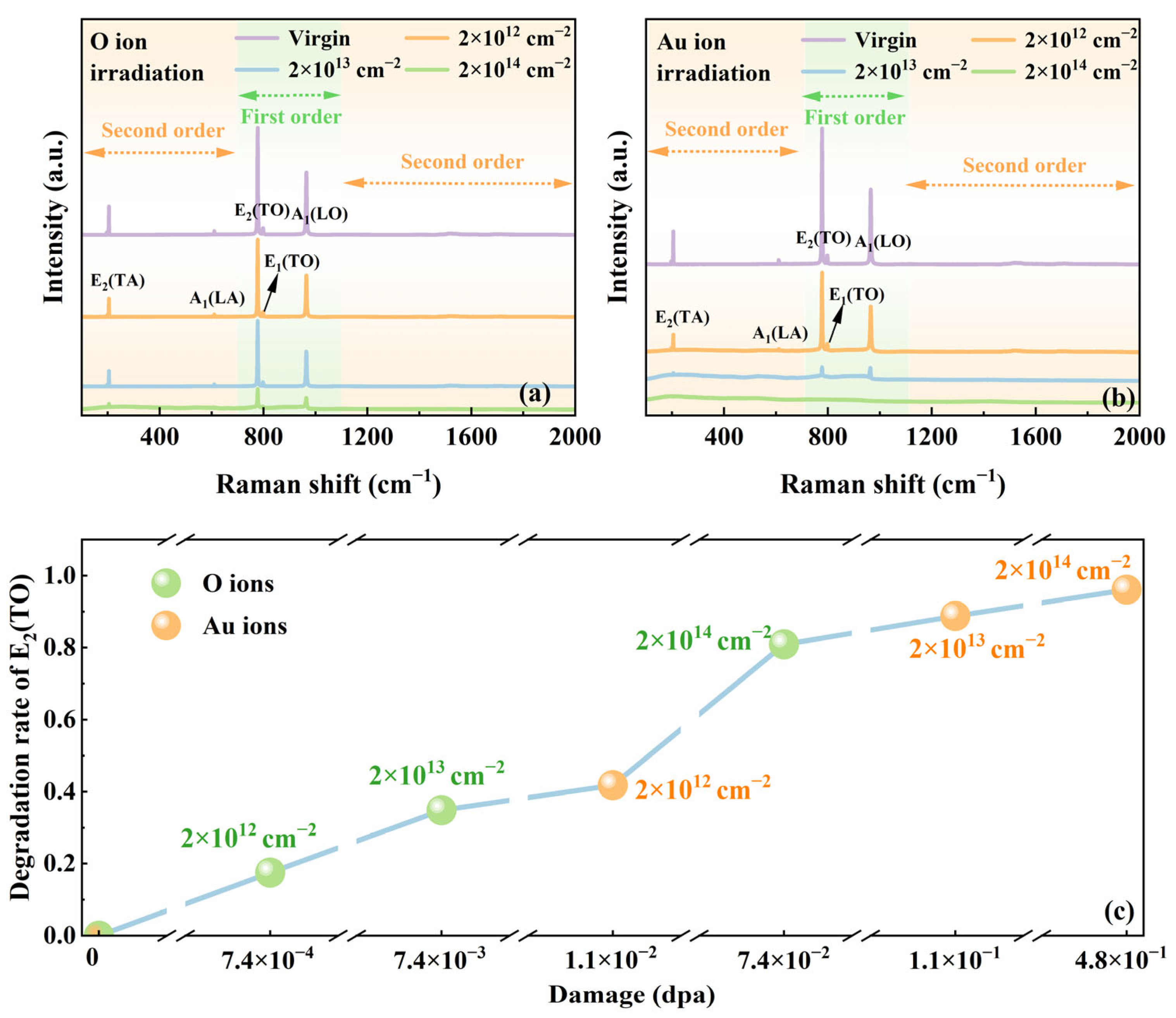
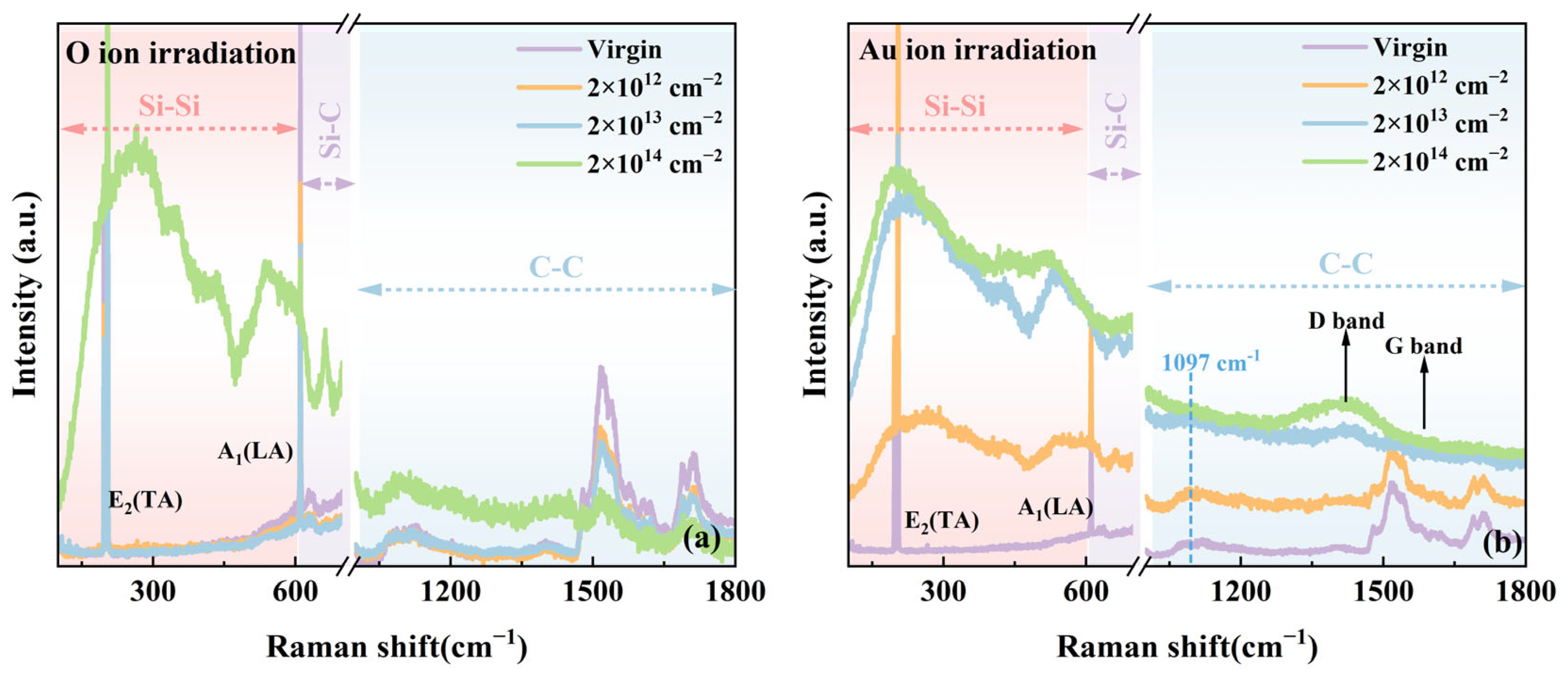

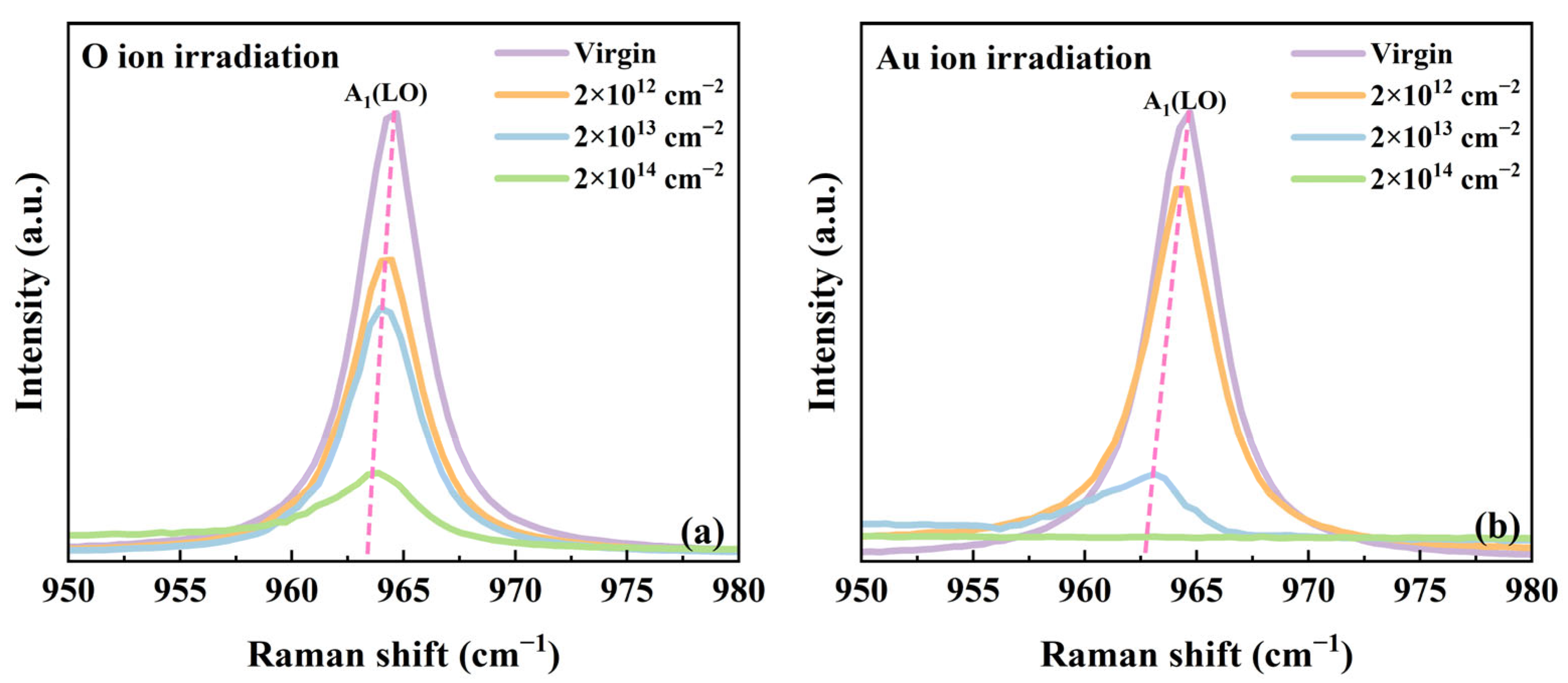
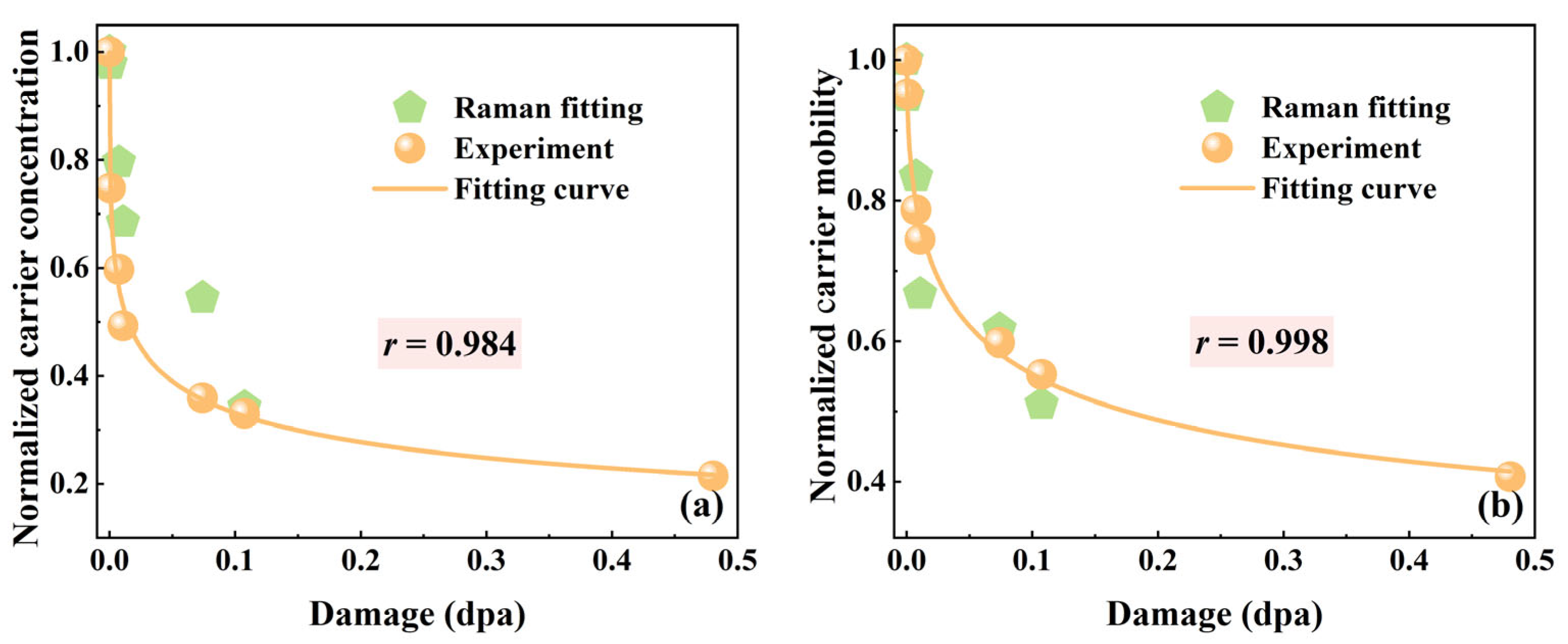

Disclaimer/Publisher’s Note: The statements, opinions and data contained in all publications are solely those of the individual author(s) and contributor(s) and not of MDPI and/or the editor(s). MDPI and/or the editor(s) disclaim responsibility for any injury to people or property resulting from any ideas, methods, instructions or products referred to in the content. |
© 2025 by the authors. Licensee MDPI, Basel, Switzerland. This article is an open access article distributed under the terms and conditions of the Creative Commons Attribution (CC BY) license (https://creativecommons.org/licenses/by/4.0/).
Share and Cite
Dai, H.; Hou, Z.; Han, X.; Liang, J.; Jiao, A.; Wei, Z.; Wu, C.; Sun, K.; Liu, Y.; Wang, X. Non-Destructive Evaluation of Damage and Electricity Characteristics in 4H-SiC Induced by Ion Irradiation via Raman Spectroscopy. Materials 2025, 18, 5057. https://doi.org/10.3390/ma18215057
Dai H, Hou Z, Han X, Liang J, Jiao A, Wei Z, Wu C, Sun K, Liu Y, Wang X. Non-Destructive Evaluation of Damage and Electricity Characteristics in 4H-SiC Induced by Ion Irradiation via Raman Spectroscopy. Materials. 2025; 18(21):5057. https://doi.org/10.3390/ma18215057
Chicago/Turabian StyleDai, Hui, Zhiyan Hou, Xinqing Han, Jiacheng Liang, Anxin Jiao, Zhixian Wei, Chen Wu, Ke Sun, Yong Liu, and Xuelin Wang. 2025. "Non-Destructive Evaluation of Damage and Electricity Characteristics in 4H-SiC Induced by Ion Irradiation via Raman Spectroscopy" Materials 18, no. 21: 5057. https://doi.org/10.3390/ma18215057
APA StyleDai, H., Hou, Z., Han, X., Liang, J., Jiao, A., Wei, Z., Wu, C., Sun, K., Liu, Y., & Wang, X. (2025). Non-Destructive Evaluation of Damage and Electricity Characteristics in 4H-SiC Induced by Ion Irradiation via Raman Spectroscopy. Materials, 18(21), 5057. https://doi.org/10.3390/ma18215057






